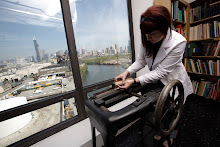
If the flaneur chooses or is allowed to "use his time deliberately and generously", with a "freely roaming attitude, leisurely lack of purpose and slight indifference", what does the flaneur give most importance to? Simply the act of looking?
With the advent of gas-lighting in the 1840's it enabled the ability for the flaneur to thrive, allowing the all day pursuit of continual looking at everyday exteriors. A modern flaneur of sorts could be embodied by the ever present security cameras, cropping up more frequently. It looks with equal importance to all it "sees".

As the industrial age progressed and there was more to observe, reflect upon and have an emotional connection with, a continuous shift of external stimuli was circling. With these shifts in the urban space, with more things ever present, visual sensitivities increase to respond to the outward demands of the senses. The flaneurs' slow movement is in direct reaction to the age of acceleration. Their mentality as "the faster we see, the less we see". Visual aspects of the modern life manifest themselves through a "bombardment of images, as well as images with text". There is a significant rise of advertising [including: "billboards, posters, placards, store signs, shop fronts, display windows"], all which "competes for the attention of passengers, pedestrians and passerby in the city". This kaleidoscope of images and text attempts to composite one whole image.
How do we filter out all the information in our modern cities? Can one take in all the information equally and justly as the 19th century flaneurs' skill-set boasted? What do we give priority to? Who and what dictates how we give priority to readership?
 A style of the "litfabsualen". A cylinder shaped structure used for posting advertisements at eye level, on all surfaces, as to attract visual contact from all directions.
A style of the "litfabsualen". A cylinder shaped structure used for posting advertisements at eye level, on all surfaces, as to attract visual contact from all directions.  Photo credit [Matt Siber].
Photo credit [Matt Siber].As Baudelaire talks of the arcades of Paris, which helped aid the rise of the flaneur, he is quoted to seemingly "love the life" of strolling and looking. He found solitude while being immersed in the crowd. Before and during Haussmann's modern changes for Paris in the Second Empire, arcades flourished as a place to showcase new lighting and what that did to transgress the lines between the interior and exterior. Arcades created a virtual interior of the boulevards of the outdoors. These arcades served as a management of sorts to contain the outdoors and make it more tangible.

Simmel suggests how the eye is used more than the ear in the big city. With the advent of public transportation, we freely choose or are forced to look at and be with one another. But, we can use looking as one form to learn something of one another. In Edgar Allen Poe's Man in the Crowd, he follows the decrepit old man to and fro from his stance in the coffee shop through the streets of London. Poe summarizes the generalities of his physique. When following closer, but as not to be seen looking, Poe takes a chance to examine his person. He notices the change of gait. When the old man gets to a bazaar and traverses through the shops and inspects the variety available by the sellers, he slows and travels with less object. Poe looks at the flaneur in his story without being looked upon. This sense of voyeurism and attempting to learn, or just feel by looking is reminiscent of Merry Alpern's photographs from her "Dirty Window" series.

If at times of social destabilization the flaneur can arise, the American Theodore Davis writes post Civil War about how art should have increased access. He pressures the National Gallery of Art in 1870, to accommodate the "poor, uncultivated, the businessman and the flaneur" to browse the galleries. Two years later, the museum reverses its policy and remains open on Sunday to "be friendly to the masses".
American painter Childe Hassam [1859 - 1935], who frequently painted scenes of Boston's Back Bay area circa 1880's, commented on his "interest in simply looking at the driver" and the desire to learn about his comings and goings.

Another American's point of view of the flaneur was critic: Mariana Griswold Van Rensselar. In response to the Columbian Exposition in Chicago of 1893, she writes an article "At the Fair" in Century Magazine #46 [May 1893] on how to have the best experience while at the fair. "To act as flaneur.". If the true flaneur has interest in only one thing, his capacity for the reception of new ideas and emotions, not craving knowledge but delighting in impressions; she stresses to really absorb it [the fair], one cannot rush. If you set a leisurely pace, you can create passive absorption.

The flaneur's object could be explored at home and when traveling if possible to treat sight seeing as not such hard work - but easy going. Holding oneself passive, but perceptive.


No comments:
Post a Comment